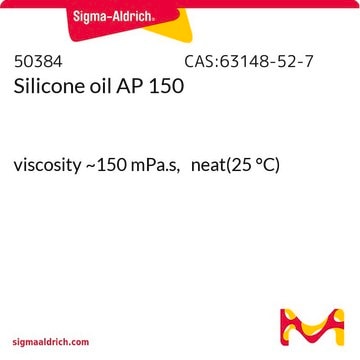The silicon oil products are not tested for melting point range. The product SDS reports the melting point based on the published physical properties of materials that fall under a given CAS number. Products under CAS# 63148-62-9 report a melting point of -55°C. The CAS# 9016-00-6, Polydimethylsiloxane. lists a melting point of -50°C.
146153
Silicone oil
for melting point and boiling point apparatuses
About This Item
Prodotti consigliati
Densità del vapore
>1 (vs air)
Tensione di vapore
<5 mmHg ( 25 °C)
5 mmHg ( 20 °C)
Tipo
for melting point and boiling point apparatuses
Parametri
−40-350 °F temp. range (−40-175 °C)
Indice di rifrazione
n20/D 1.403 (lit.)
Viscosità
45.0-55.0(25 °C)
P. eboll.
>140 °C/0.002 mmHg (lit.)
Densità
0.963 g/mL at 25 °C
Cerchi prodotti simili? Visita Guida al confronto tra prodotti
Applicazioni
- for melting-point and boiling-point apparatus
- in membrane contactors to impregnate fibers
- on rheometer samples (chicken skin and bovine gelatin) to prevent evaporation during heating using temperature sweeps and frequency sweeps
Azioni biochim/fisiol
Caratteristiche e vantaggi
- High viscosity
- Low water solubility
- Low vapor pressure
Codice della classe di stoccaggio
10 - Combustible liquids
Classe di pericolosità dell'acqua (WGK)
WGK 1
Punto d’infiammabilità (°F)
214.0 °F - closed cup
Punto d’infiammabilità (°C)
101.1 °C - closed cup
Dispositivi di protezione individuale
Eyeshields, Gloves
Scegli una delle versioni più recenti:
Certificati d'analisi (COA)
Non trovi la versione di tuo interesse?
Se hai bisogno di una versione specifica, puoi cercare il certificato tramite il numero di lotto.
Possiedi già questo prodotto?
I documenti relativi ai prodotti acquistati recentemente sono disponibili nell’Archivio dei documenti.
I clienti hanno visto anche
-
What is the part number of silicon oil that has a melting point at around - 50C.
1 answer-
Helpful?
-
Active Filters
Il team dei nostri ricercatori vanta grande esperienza in tutte le aree della ricerca quali Life Science, scienza dei materiali, sintesi chimica, cromatografia, discipline analitiche, ecc..
Contatta l'Assistenza Tecnica.






